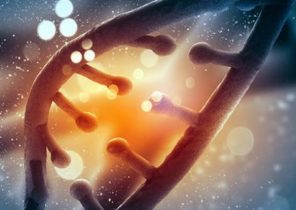A fundamentally new method of imaging of molecules known as cryoelectron microscopy, gave us a very clear picture for today, and we had a first opportunity to examine individual atoms in a protein.
Achieving resolution of atomic scale with the use of cryogenic electron microscopy (cryo-EM), scientists will be able to study in detail the mechanisms and the proteins device, that it was impossible to make by other methods of imaging such as x-ray crystallography.
About this revolutionary achievement at the end of the vulgar months reported by two laboratories. It will strengthen the position of the cryo-EM as a main tool for building three-dimensional models of proteins, scientists say. Eventually these structures will help researchers to understand how proteins work in a healthy and diseased organism, and will allow you to build better drugs without serious side effects.
“This is truly a momentous event, no doubt about it. More open nothing. It was the last barrier of detail,” says the biochemist and specialist in electron microscopy Holger stark (Holger Stark), working in göttingen in Germany at the Institute for biophysical chemistry, max Planck and who led one of the studies. A second study led by structural biologists SORS Shares (Sjors Scheres) and Aricescu Radu (Radu Aricescu) working in the laboratory of molecular biology medical research Council in Cambridge UK. On may 22 both studies posted on the Preprint server bioRxiv.
The “true “atomic resolution” is the most important stage,” says structural biologist John Rubinstein (John Rubinstein) from the University of Toronto in Canada. To the structure of many proteins at atomic resolution scale will still be very difficult because there are many other problems, such as the flexibility of the proteins. “These studies show what can be achieved if overcome other limitations”, — said the scientist.
Breaking through the boundaries
Cryoelectron microscopy has existed for decades. With its help determine the form of quick-frozen samples by firing electrons at them and fixing the resulting image. Advances in detection technologies ricochet of electrons and creation of programs for image analysis have given rise to “revolution resolution” that started around 2013. It is possible to obtain a clearer picture of protein structures. It was almost the same, which gives x-ray crystallography. It is an older method of determining the three-dimensional structure of biological macromolecules by diffraction of crystallized proteins, bombarded with x-rays.
New hardware and software allowed to improve the resolution of cryo-EM. But to produce structures at atomic resolution, scientists still had to resort to x-ray crystallography. However, crystallization of the protein took months, and even years, and many important from the point of view of medicine in General proteins are not created suitable for studying crystals. Cryoelectron microscopy requires only one thing — that protein was purified in solution.
Maps of atomic resolution precise enough to unambiguously identify the location of individual atoms in a protein at a resolution of about 1.2 angstroms (1,2 × 10-10 m). These structures help to understand how enzymes work, and this understanding allows you to identify the drugs affecting their activity.
To bring the cryo-EM on the level of atomic resolution, two teams of scientists worked with a protein called apoferritin that binds iron. Since this protein consistently stable, it made a testbed for cryo-EM. Previously, the record was the structure of the protein with a resolution of 1.54 Angstrom.
Then, scientists have used technological improvements to obtain a clearer picture apoferritin. Team stark got a protein structure with a resolution of 1.25 angstroms, using the device ensuring the movement of electrons with the same speed before hitting the sample. This increased the resolution of the obtained images. Shares, Aricescu and their colleagues have used new technology to bombard samples with electrons moving at the same speed. They also used technology to reduce the noise after the ricochet part of the electrons from the sample, and a more sensitive camera for the detection of electrons. According to Seresa, their structure in solution of 1.2 Angstrom was so full that they were able to see separate atoms of hydrogen in the protein and surrounding water molecules.
Stark is confident that, if we combine these technologies, the resolution can be brought to one Angstrom, but no more. “Using cryo-EM to fall below one Angstrom is almost impossible,” he says. To obtain such a structure by using current advanced technologies, have “a few hundred years to collect data, and will require enormous computational resources and memory capacity,” says research team stark.
It is clear to see the picture
Shares and Aricescu also experienced their improvements on a simple form of a protein called GABA receptors. This protein is in the membrane of neurons, and it is exposed to anesthetics General actions, tranquilizers and many other drugs. Last year, the group Aricescu used cryo-EM to examine the protein with a resolution of 2.5 Angstrom. But with the new technique, researchers achieved a resolution of 1.7 angstroms, and in some parts of the protein, it was even better. “It seems that my eyes blurred, says Aricescu. — At this resolution every half-Angstrom open up the whole universe”.
They were able to see in the protein such details, which no one has seen before, including water molecules in the part where the substance histamine. “This is a real gold mine for the creation of structured drugs, says Aricescu, because it shows how the drug can replace the water molecules. This can lead to drugs with fewer side effects”.
Create a map of GABA with a resolution of atomic scale would be difficult because the gamma-aminobutyric acid is not as stable as apoferritin says Seres. “I think it’s possible, but practically it is impossible”, — he said. The fact that you have to collect huge amounts of data. However, other improvements, in particular, in the method of preparation of protein samples, will help to reach the level of atomic resolution structures of GABA and other important biomedical proteins. Protein solutions are frozen on the tiny grates of gold, and changes in these grids will help to provide enhanced stability of proteins.
“All delighted and filled with admiration for the truly remarkable results achieved by teams from the Institute for biophysical chemistry, max Planck and molecular biology laboratory, medical research Council,” — said the expert on cryoelectron microscopy from the University of Tokyo Radostin Danev (Radostin Danev). But he, too, agrees that the preparation of the samples of the most unstable proteins would pose a serious problem for this area of research. “To reach a resolution below one and a half and even two angstroms for some time will be available only for stable samples,” he says.
According to Seresa, new developments will lead to the fact that cryo-EM will become an indispensable tool in most structural studies. Pharmaceutical companies, eager to obtain structures with atomic resolution, with an even greater desire to do cryoelectron microscopy. However, stark believes that x-ray crystallography will also retain its appeal. If the protein will fail to crystallize (and this is a big if), it can be quite effectively and quickly to create the structures associated with thousands of potential drugs. But to obtain a sufficient number of data structures using cryo-EM of very high resolution will still take hours and even days.
“Each of these methods there are the arguments “for” and “against,” says stark. — People post a large number of papers and reviews, which say that the latest achievements in the field cryoelectron microscopy doom to death x-ray crystallography. But I doubt it.”







